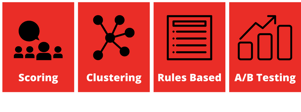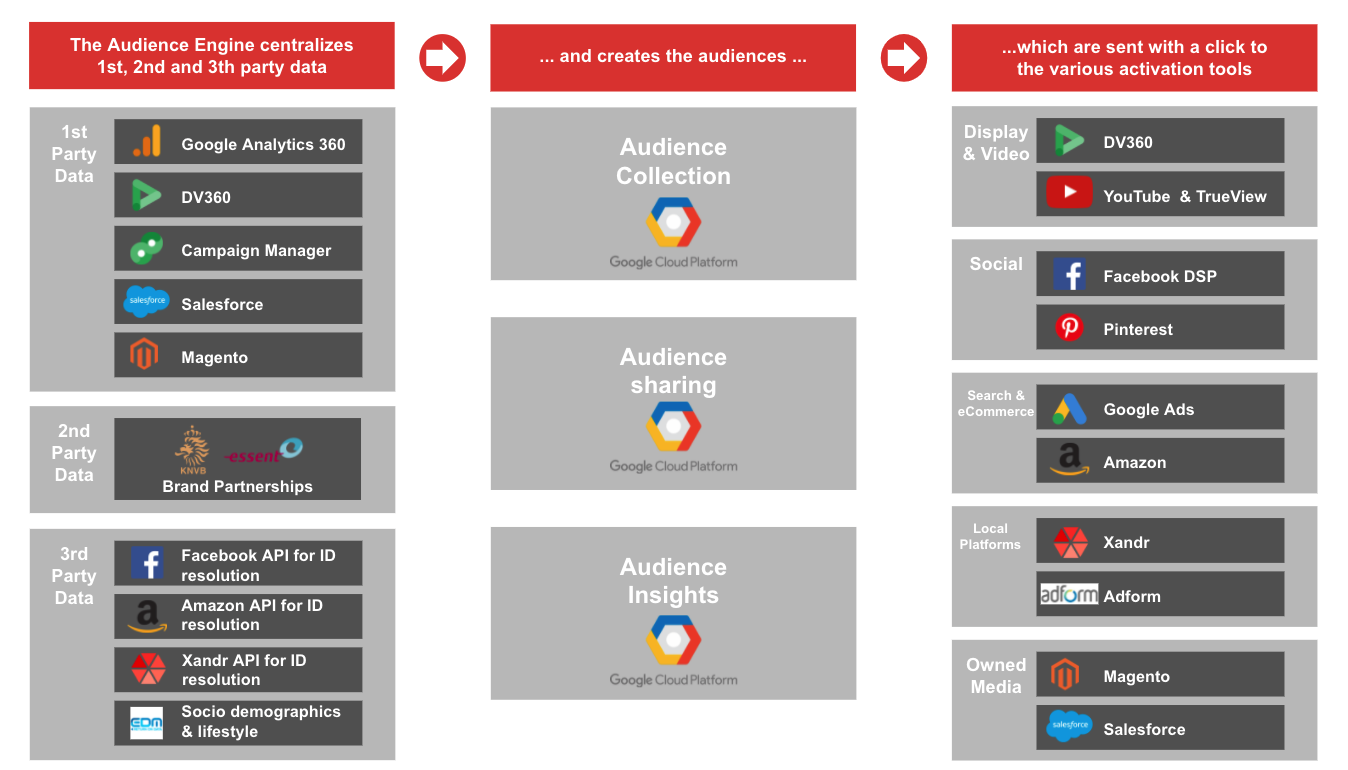Share this
Segmenting and activating audiences using AI in a Customer Data Platform
by Jan Hendrik Fleury on Jan 11, 2022 8:47:34 PM
The changes in the technical and regulatory environment around collecting and processing personal data are impacting the ability of companies to precisely target and measure their audiences. Brands have to review their data strategies to continue to accurately reach their audiences and optimize their media budgets.
No need to lose sleep because there is a proven solution: the implementation of an AI-based Marketing Engine in a custom-build CDP on Google Cloud Platform.
This flexible solution enables you to exploit first-party data to its full potential, in full compliance with regulations. This solution allows audiences to be segmented in an automated way adopting MLOps for managed activation across all owned, earned, and paid digital marketing platforms.
Embrace the change by building the solution
The disappearance of third-party cookies and the decrease in the volume of first-party data make targeting and retargeting more challenging. The technologies that will replace third-party cookies won’t achieve the same degree of relevance and volume. Measurement capabilities will be considerably reduced: it will no longer be possible to track and reconcile all digital touchpoints. And complying with regulations will make collecting and processing personal data more complex.
The ability to deal with these constraints is an opportunity to distinguish yourself
The key is to build a consumer data strategy:
- Collect first-party data (CRM, website and app browsing, media, PoS, etc.) to be able to exploit their full potential;
- Build a flexible and tightly integrated ecosystem of systems and apps to activate this data and measure marketing action performance; a Customer Data Platform, or CDP, which I will discuss later in this article;
- Enrich first-party data with external data, third-party data such as socio-demographics, and second-party data, which is legitimately shared with another company.
We have developed this kind of solution several times, both in B2B, such as for FD Media Group and in B2C and D2C eCommerce.
AI with Marketing Audience Engines to optimize and personalize your campaigns
To personalize and optimize digital marketing campaigns, you need to be able to build relevant and easily activatable segments. This is the role of Marketing Activation and Analytics Clouds that are being built on the Google Cloud Platform. Google Cloud is most suited for this if you ask me. It is the ease of build and ease of integration of Google Cloud, and the native integrations with the Google advertising and measurement ecosystem such as Google Ads, and Google Analytics.
Audience engines adopt MLOps principles and centralize site-centric and app data, always while respecting the user’s data privacy. Second- and third-party data are added to enrich proprietary data.
These data can then be aggregated using algorithms that can have different functions, some of which are noted below:

- Scoring: calculation of a specific value at the visitor or customer level, or assignment to a group at a segment level. Input features can include browsing data, purchase history, email interactions, socio-demographics, etc. After distinguishing the targeting strategy using these scores, the onsite/in-app and advertising content (messages, creatives, offers) can be customized for each population. This also helps optimize media investments through biddings adjustments based on the value attributed to an audience segment.
- Clustering or look-alike: assembling audience communities and connecting them to marketing activation platforms to enable audience extension.
- Rules-based audience: in eCommerce, rule-based audiences can be made using transactional activities (checkout date, coupon applied, etc.), marketing actions (email opened, promotion entered, etc.), or even product details (eg. type of product, color or type purchased).
- A/B testing and Insights: isolation of part of the audience to verify the relevance of digital strategies and created audiences. In this way, segmentation capabilities can be continuously improved.
Adopting MLOps principles will allow for automation of continuous training and monitoring of models/segment creation. The resulting audience segments can be fed into the advertiser’s ecosystem of activation platforms in near real-time.

Conclusion
What are the key takeaways to successfully engaging in your first-party-driven digital transformation journey? Crystalloids’ top 4 recommendations:
- Define a data strategy to own and expand your first-party data (digital assets, data quality, data governance)
- Define a long list of use cases and prioritize based upon uplift gains, ease of implementation with the help of a partner who is experienced in what works and what doesn’t
- Design a CDP on Google Cloud yourself with help of a specialized Marketing Analytics partner. In most cases, we see a packaged / off-the-shelf CDP is not the (only) solution because you need to be able to tailor to your situation in a flexible and cost-effective manner because there is no single solution that fits with your current and unknown future requirements.
- Next to MLOps, adopt principles such as MarketingOps and DevOps to be able to execute on the CDP by aligning the CDP technology with legal, creative, content, and UX.
Share this
- April 2025 (4)
- February 2025 (2)
- January 2025 (3)
- December 2024 (1)
- November 2024 (5)
- October 2024 (2)
- September 2024 (1)
- August 2024 (1)
- July 2024 (4)
- June 2024 (2)
- May 2024 (1)
- April 2024 (4)
- March 2024 (2)
- February 2024 (2)
- January 2024 (4)
- December 2023 (1)
- November 2023 (4)
- October 2023 (4)
- September 2023 (4)
- June 2023 (2)
- May 2023 (2)
- April 2023 (1)
- March 2023 (1)
- January 2023 (4)
- December 2022 (3)
- November 2022 (5)
- October 2022 (3)
- July 2022 (1)
- May 2022 (2)
- April 2022 (2)
- March 2022 (5)
- February 2022 (3)
- January 2022 (5)
- December 2021 (5)
- November 2021 (4)
- October 2021 (2)
- September 2021 (2)
- August 2021 (3)
- July 2021 (4)
- May 2021 (2)
- April 2021 (2)
- February 2021 (2)
- January 2021 (1)
- December 2020 (1)
- October 2020 (2)
- September 2020 (1)
- August 2020 (2)
- July 2020 (2)
- June 2020 (1)
- March 2020 (2)
- February 2020 (1)
- January 2020 (1)
- December 2019 (1)
- November 2019 (3)
- October 2019 (2)
- September 2019 (3)
- August 2019 (2)
- July 2019 (3)
- June 2019 (5)
- May 2019 (2)
- April 2019 (4)
- March 2019 (2)
- February 2019 (2)
- January 2019 (4)
- December 2018 (2)
- November 2018 (1)
- October 2018 (1)
- September 2018 (2)
- August 2018 (3)
- July 2018 (3)
- May 2018 (2)
- April 2018 (4)
- March 2018 (5)
- February 2018 (2)
- January 2018 (3)
- November 2017 (2)
- October 2017 (2)


